The next morning we docked at Khasab, Oman, on the Musandam peninsula. This enclave jutting out into the Strait of Hormuz is separated from the rest of Oman by the UAE and has a culture all its own. The local people identify themselves as the Shihuh tribe and are ethnically distinct from the neighboring peoples. They believe they came from Yemen in the 2nd century AD. They are farmers, not nomads, and supplement their agricultural production with fishing. There is another distinct ethnic and linguistic group in the area located in Kumsar, on the northern tip of the peninsula.
The inhospitable mountains and reclusive character of both these peoples have kept them isolated until recently, but this has been changing with modern communication technologies and the unification goals of Sultan Qaboos, the leader of Oman (more on him later).
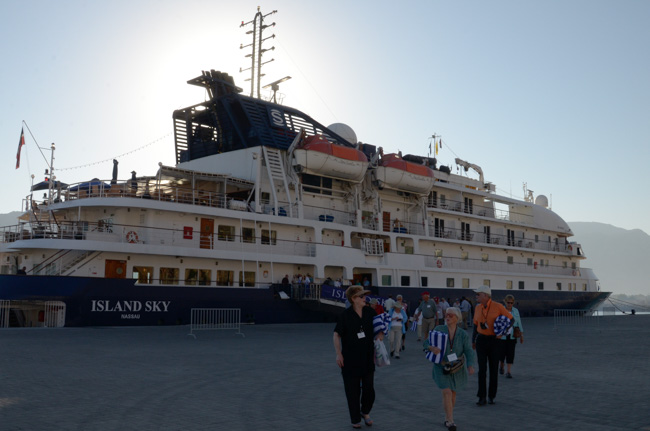 The
day started with our exploration of a
craggy
fjord on a pair of large motorized
dhows. Our goal was
a snorkeling site, but there was much to see on the way.
The
day started with our exploration of a
craggy
fjord on a pair of large motorized
dhows. Our goal was
a snorkeling site, but there was much to see on the way.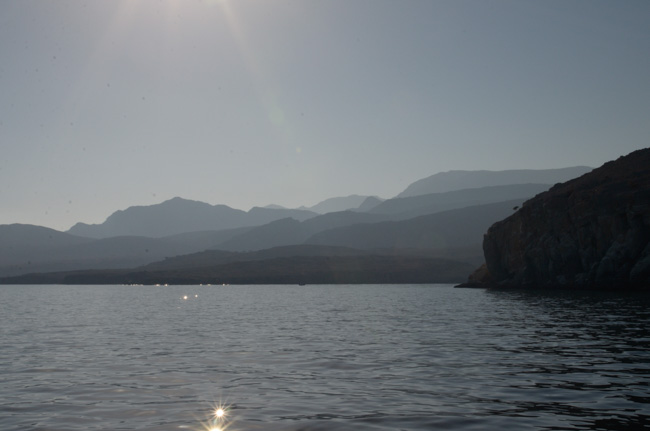
The beautiful and eerie scenery of overlapping ranges in the fjord.
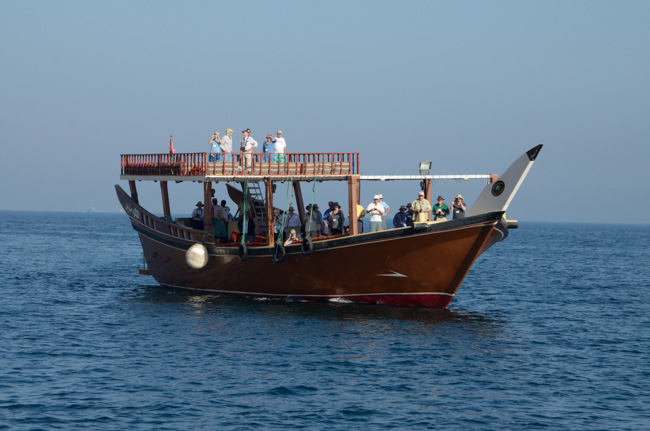
Before long we encountered a pod of endangered humpback dolphins. Our two boats circled slowly while we pointed and oohed and took countless pictures.
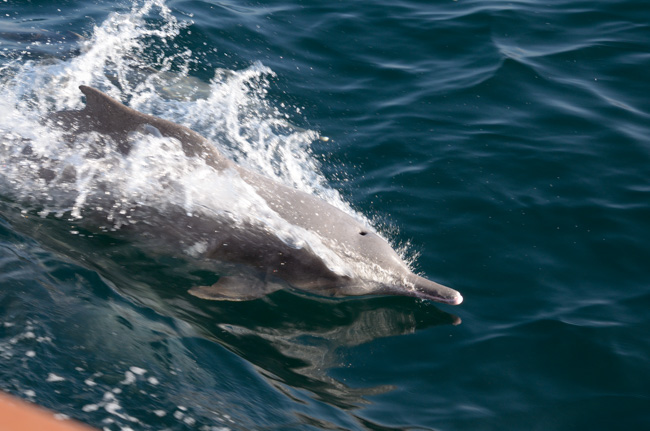
The dolphins' main focus may have been the fish, but they were curious about us as well.
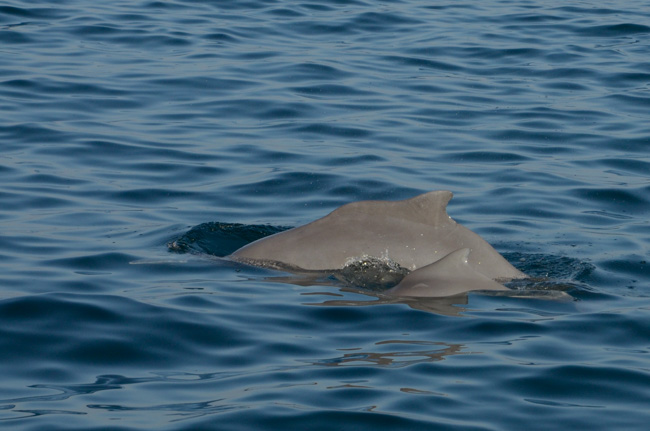
The group even included a mother and her young calf.
This image shows the hump for which the species is named.
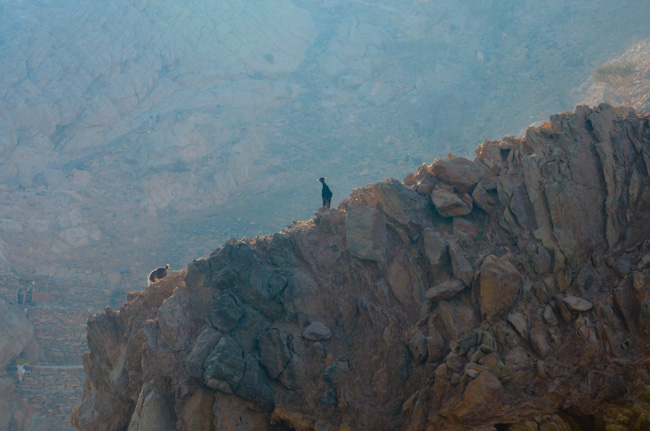
As we bade goodbye to the dolphins and proceeded further into the fjord, we saw goats perched on top of a ridge. The dhow excursions must commonly stop here because soon a large flock scrambled down the ridge to the water's edge where our guides tossed them bananas and other fruit.
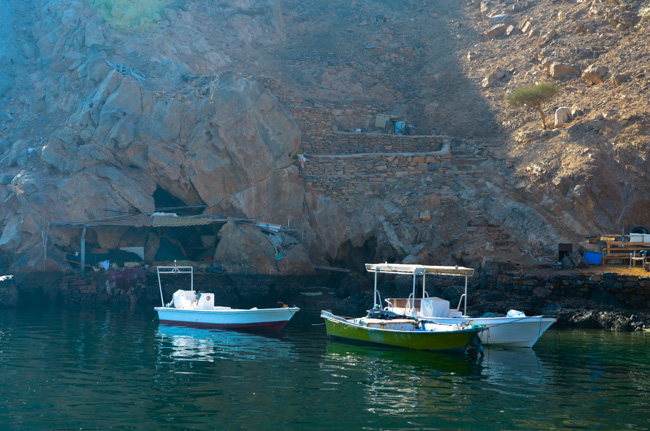 Behind
the ridge is a partial cave / partial stone hut with terraces built
nearby. These habitations are typical of the Shihuh summer
homes.
Behind
the ridge is a partial cave / partial stone hut with terraces built
nearby. These habitations are typical of the Shihuh summer
homes.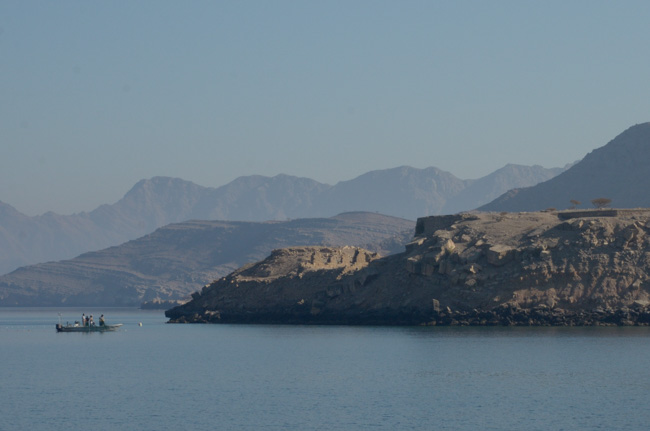 Our
snorkeling location was
Telegraph Island.
It contains the remnants of a 19th century repeater station used to
boost the telegraph signals on the London to Karachi cable.
Our
snorkeling location was
Telegraph Island.
It contains the remnants of a 19th century repeater station used to
boost the telegraph signals on the London to Karachi cable.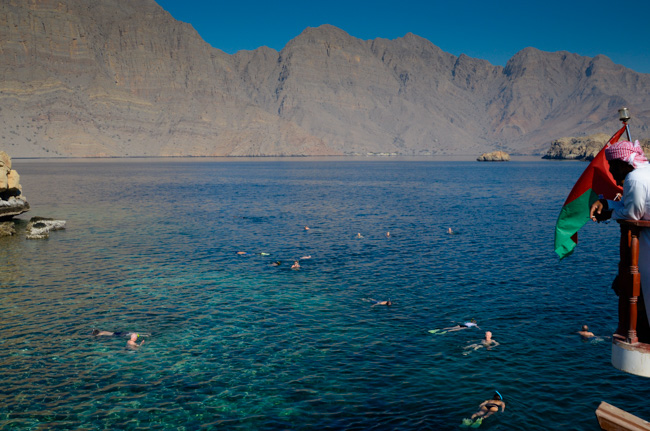
A significant number of our group took the opportunity for a dip. A couple of women who didn't come prepared with swimsuit and towel simply jumped in anyway! They had a great time.
Our tour staff provided snorkeling gear.
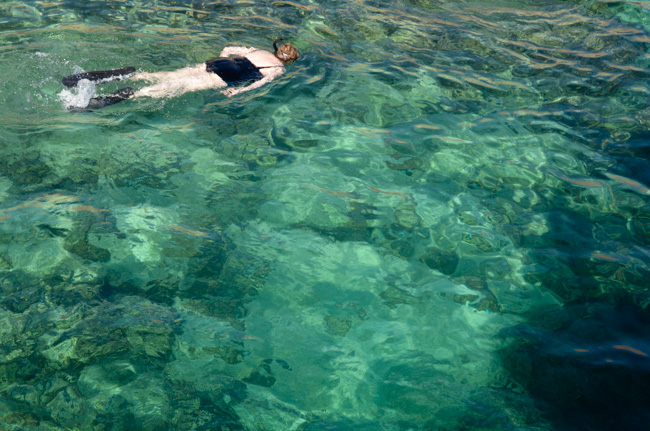
The main attractions were the corals and the numerous types of fish.
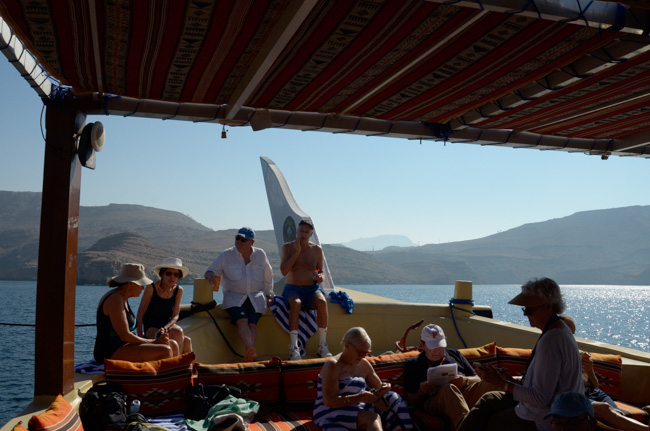
The dhow was well supplied with snacks so we had plenty to nibble and sip during our return to Khasab. I continue to be amazed at the connection people, even "old folks" like ourselves, have to their electronic leashes. Here we are in remote Oman and there are a couple of ladies in this picture checking their cell phones. Even if they are looking at recent photos rather than checking Facebook, the countryside was gorgeous in its austere way and worthy of more attention.
OK, end of rant.
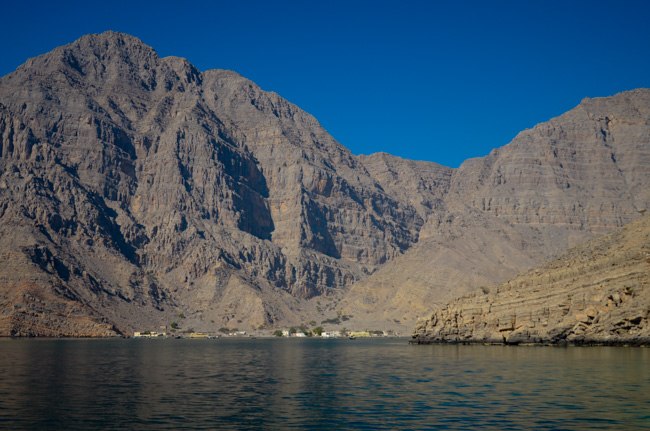
The dhow route took us along the craggy and barren cliffs where we saw isolated fishing huts and this one small settlement.
The local people still don't welcome strangers. Our guides pointed out buoys marking nets strung to keep out intruders.
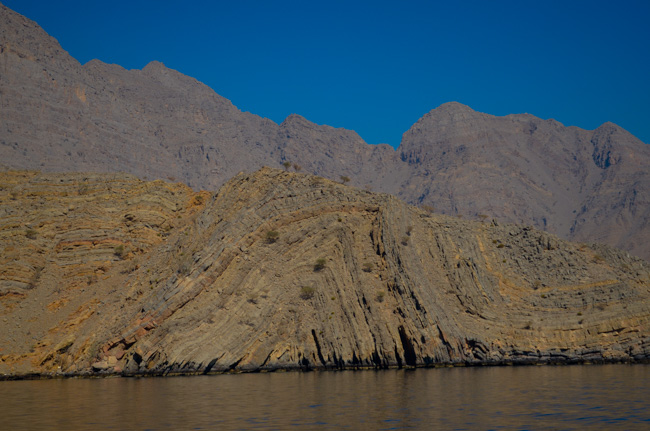
The colors and shapes of the rocks along the way were fascinating. It was hard to capture colors in the brilliant light, but this image shows some of the intense deformation of the rocks due to geologic forces. The area is located where the Afro-Arabian and Eurasian plates meet. Most plate boundaries experience subduction, but here the process was obduction, which pushed the older oceanic crust over the continental area. (I had found a web site that had better explanations, but it's disappeared.)
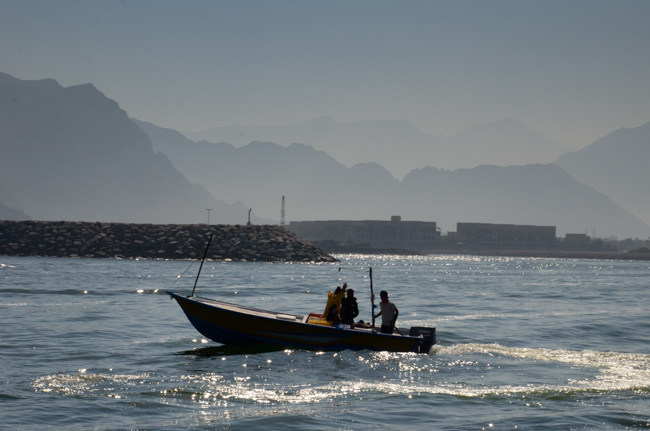 As
we returned from our expedition we passed
Iranian smugglers headed home in a small fast boat. Since the
smugglers pay all applicable Omani taxes,
their operations are above-board -- at least in Khasab. They laid
down a watery donut and gave us a big wave.
As
we returned from our expedition we passed
Iranian smugglers headed home in a small fast boat. Since the
smugglers pay all applicable Omani taxes,
their operations are above-board -- at least in Khasab. They laid
down a watery donut and gave us a big wave.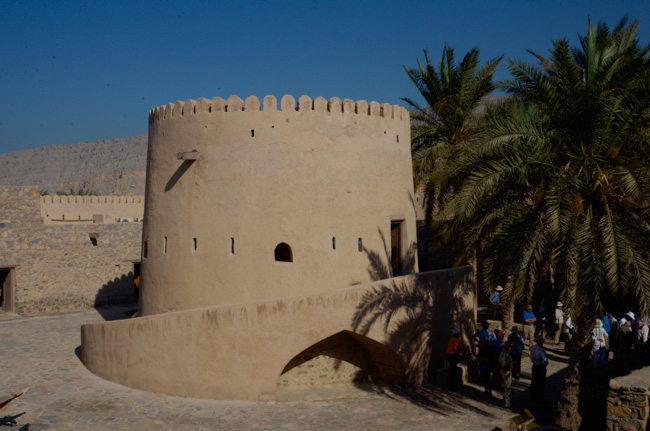
After lunch we toured the city and surrounding area.
Khasab Castle contains interesting displays showing traditional lifestyles of the area. The current form of the castle, which has been extensively restored, was established by the Portuguese in the 17th century on the foundation of an older fort. They only held the area for a short time before it was reconquered by the Omanis. It has remained in Omani hands ever since.
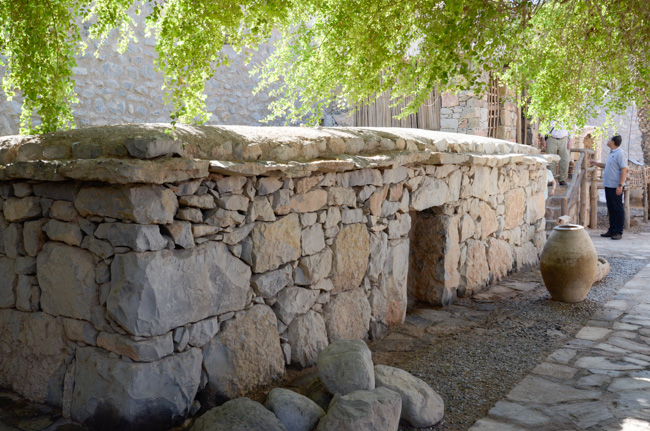
There were two displays that I particularly liked. The native people, although not nomadic in the same sense as the Bedouin, did relocate from their mountain farms to the seaside in the summer. The winter, with its cooler temperatures and more rain, was their farming season. During the dry and blistering summer they lived by the seaside and fished.
This building is a storehouse, Bait al Qufl or "House of the Lock," used to store grain, water, dates and other possessions while the owners were away. There is only one door, which can be securely locked. Moreover the storage vessels were too large to be removed through the door. They were put in while the structure was being built.
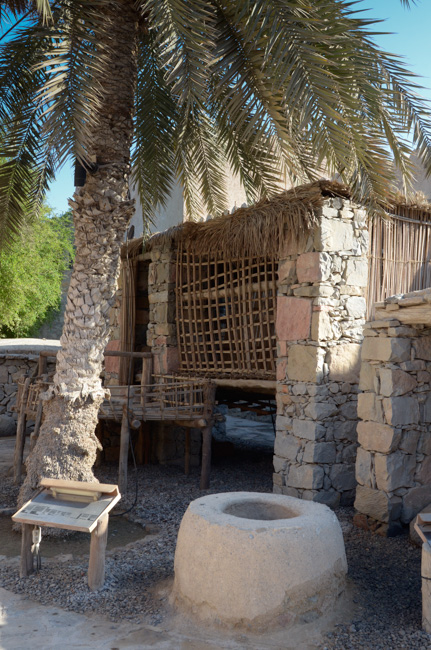
This summer house or Arish is constructed of palm fronds and situated to catch the slightest breeze. Even the floor was open weave. Families return to the same structure year after year and refurbish it as needed.
The round structure in front of the structure is a tandoor oven.
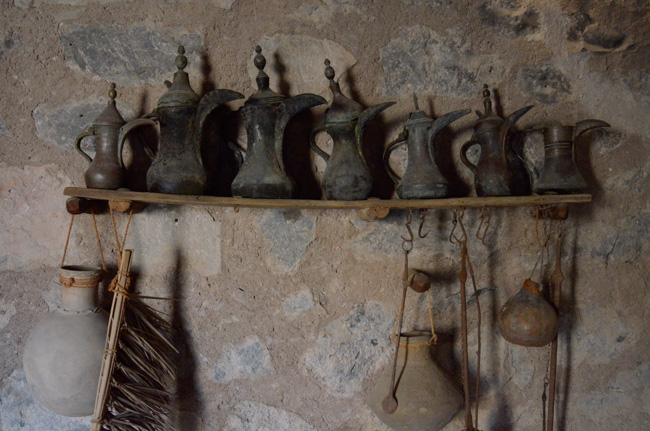
The kitchen of the fort displayed traditional coffee pots.
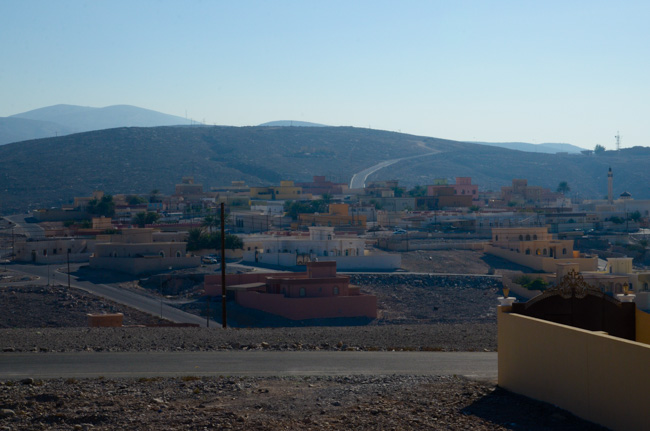
This is what villages look like nowadays. The government sells land inexpensively and helps with low-cost construction loans. As a result most villagers have opted for air-conditioning and modern conveniences in newly-constructed family compounds. We saw similar villages throughout Oman.
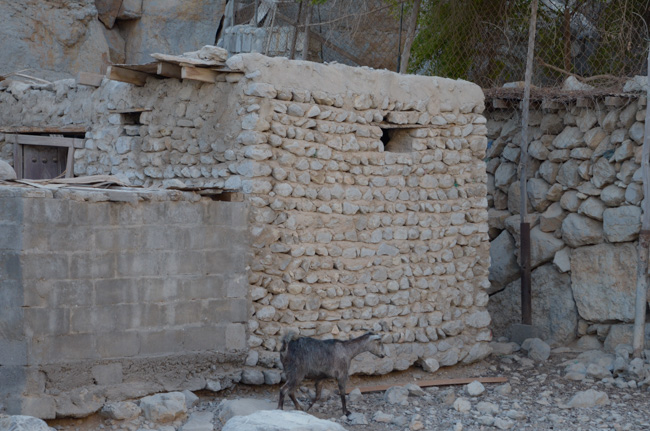
This traditional village was located on a small bay. Nowadays it is home mostly to goats although there were some signs of relatively recent construction -- mostly for store houses.
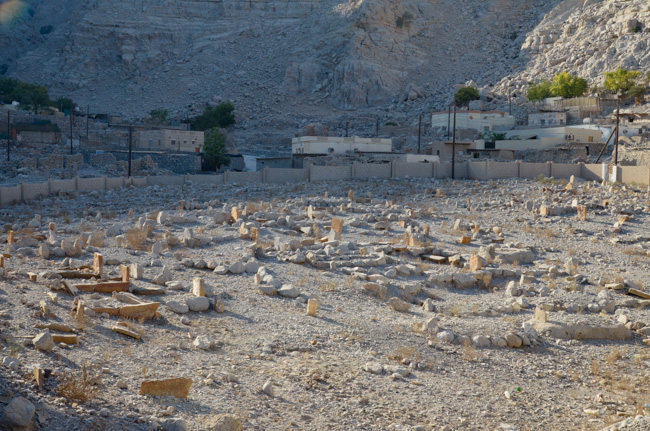
This is a very typical Omani cemetery in the above village. It is still actively being used. The cemeteries always looked more-or-less like rock piles, but the placement and configuration of the rocks has meaning to those who use them. Islamic tradition forbids too much emphasis on tombs lest they become locations for idolatry. In most Muslim countries we have visited, this tradition is not rigorously honored, especially where the "rich and famous" are concerned, but it seemed to be the norm here.
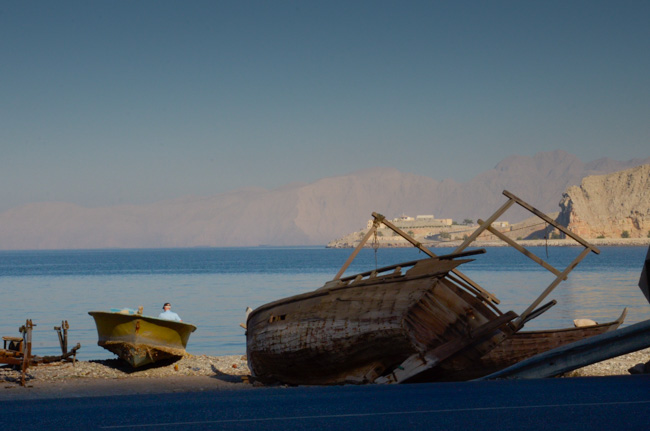
The small harbor associated with the village also seemed abandoned. As is the case the world over, people are leaving rugged traditional ways of life for easier jobs in towns and cities.
The haze veiling the far mountains is due to humidity. I was astonished (and dismayed) to learn than in addition to the punishingly high temperatures, much of the region is also subject to high humidity!
After we left Khasab for our next Oman destination, we enjoyed another lecture by Dr. Milani. The subject was the three trends in Islamic development over time:
- Rationalism: reaching out to knowledge found in other cultures, e.g., Greece & India. The flowering of Islamic civilization and preservation of knowledge.
- Sufi mysticism: acknowledging the divine within. Ecumenical effects on other faiths, but a turn against rationalism.
- Fundamentalism: believing that all you need to know can be found in the Qu'ran and the Hadith. The search for reason is a "crusader trick." This is the source of so much trouble today.
Click your "back" button to return to the previous page or click for our picture album.